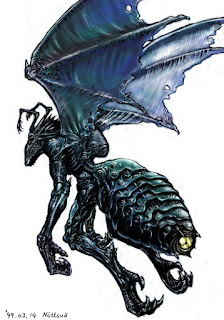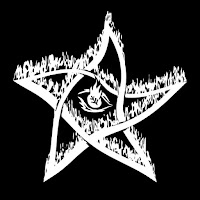I ran another session of Call of Cthulhu, starring the same characters who survived "Genius Loci" and "Ties That Bind." What follows is a write up of "None More Black," one of the adventures included in the book Doors to Darkness. Interestingly, the characters had the easiest time in this one because they adopted the tactics of the villains in Lovecraft's fiction rather than those of the protagonists. If you want plan on playing through the adventure, skip this recap! Spoilers ahead.
The Characters
Sirus Mean, former boxer and hobo
Leslie Cowell, antiques dealer
Hazel Murphy, flapper
Tony Tunacelli, wiseguy
Events
Tony got a phone call from Angelo Fratelli, a mid-level boss in the mafia. After inquiring after Tony's health, he had a favor to ask: the families had gotten word that somebody, maybe the Irish mob, was pushing a new drug on the streets of Arkham that was cutting into their heroin trade. Angelo asked Tony to report back if he heard anything about who was encroaching on mafia territory.
*
Sirus was eating breakfast at the Starlight Diner. Nance, the little blonde waitress, brought him his eggs and coffee; she asked if he had seen the report in the newspaper about the two dead students at Miskatonic University. Apparently both students had died suddenly of "natural causes," though it was reported that both students had unexplainably blackened tongues at the time of their deaths.
*
Leslie was suffering from a recurring dream that followed the shape of the hallucinations he had experienced last session. He dreamed that the sun was waving fiery tendrils in the lurid sky; it divided into two suns, then divided again and again until the sky was filled with suns. The suns turned black. It began to rain a black, viscous fluid. Leslie saw human beings, naked and hungry and afraid, crawling under the many black suns. Their eyes were wide and wild with fear. They raised their faces toward the blighted heavens and let the black rain fall into their mouths. It ran down their bodies in rivulets. It slaked a thirst they never even knew they possessed.
*
Hazel knew Walter Resnick, a second-year student at Miskatonic University, to be a charming, kind-hearted, and attractive young man; he was a good student and well liked by all. However, when she ran into him at a local dance hall he had completely changed. At first he was acting excessively giddy; he grabbed her and insisted that she dance with him. She noticed that his tongue was black. By the end of the night he had grown irritable and picked a fight with his friends. Hazel later heard through mutual friends that he’d been missing classes and had been looking disheveled. Then, out of nowhere, Hazel got a phone call from Walter: he claimed he had something that the Arkham Historical Society needed to see.
*
Unable to obtain a response from Walter when she knocked at his door, Hazel called Leslie over to Walter's room at a local boarding house near the university. Leslie deftly picked the lock; inside, they found Walter dead in a chair at the desk. His eyes had rolled back in his head and his black tongue lolled out of his mouth. Nothing else seemed amiss, but they found several small bottles that were mostly empty--drops of a strange black substance clung to the inside of the bottles.
Leslie and Hazel picked up Tony and Sirus, then the grouped headed over to Miskatonic University to have Prof. Richard Ware examine the substance in the bottles for them. Prof. Ware was visibly startled by what he saw. He informed them that the substance appeared to be comprised mostly of alcohol, but there was a kind of cell within the alcohol that resembled a blood cell. What unnerved the professor was that the cells within the alcohol still appeared to be alive in some way.
Asking around on Miskatonic's campus revealed that the two students that had previously been reported as dead and Walter were connected by to a man named Paul Rodgers. Rodgers had been a student at the university, but had dismissed for cheating. Nevertheless, he had been frequently spotted on campus in recent memory. Surmising that Paul was dealing whatever the black substance was as a new drug, they decided to pay him a visit at his house.
Paul wasn't home when they arrived, so they let themselves in to take a look around. They noted a pair of manure-encrusted galoshes in his foyer--an odd thing to have for a guy seemingly unconnected to an agricultural trade. On his desk they discovered a scrap of paper with some sums and figures on it; the paper was torn, but the letterhead read "Campbell's Me--." Under a squeaky floorboard they found six full bottles of the black substance, a wad of cash, and a bank ledger that indicated that Paul had made a lot of money over the past two weeks.
The group figured out that the letterhead belonged to Campbell's Meat Processing, a slaughterhouse on the outskirts of Arkham. They drove out there and found an abandoned-looking slaughterhouse. No lights were on, but two older-model cars were parked outside. The group preemptively slashed the cars' tires. Unwilling to venture inside the slaughterhouse, the group devised a plan: Tony would go to town on the cars with a baseball bat, drawing any occupants outside, while the others hid and waited.
A large man came barreling out the slaughterhouse's front door in response to the ruckus; he had a revolver in his hand and took a shot at Tony, injuring him. A firefight erupted as Leslie, Sirus, and Tony returned fire. The large man seemed to take more wounds than any mortal should be able to survive; he wasn't even too phased by Hazel sneaking up on him and slashing his leg with a switchblade. He retaliated by pistol-whipping Hazel, but a shot to the forehead from Tony put him down. Leslie pried the man's mouth open and confirmed that the man had a black tongue.
During the gunfight, Sirus had spotted a number of junkie-looking miscreants running for their lives out of the back of the building.
Still unwilling to venture inside the slaughterhouse, the group decided to throw a lit stick of dynamite inside and let that take care of whatever horrors were inside. The explosives did their work, but as the building burned they saw a black, seemingly faceless, winged creature emerge from a second floor window. The creature pulled a tall, dark-haired man out after it, then flew away.
On the way back to Arkham proper, the group encountered one of the junkies who had fled the slaughterhouse. Tempting her into the car with a vial of the black substance, they pried what information they could out of her. She identified the man who was pulled to safety from the building as Jacob Dover. A few of them remembered the tragic story of the Dover family: they were a wealthy, prominent family in Arkham, but when Margaret Dover died in a boating accident twenty years ago, her husband took their son Jacob on a globe-trotting adventure. The pair had returned to Arkham just last year, but it was clear that the family fortune was now gone. Jacob's father died, and Jacob had been laying low ever since.
Following the paper trail of documents related to Jacob's purchase of the slaughterhouse, the investigators were able to get the address of the seedy apartment he was living in. Instead of picking the lock, they blew the door open with a shotgun. When Jacob emerged from the darkness of the apartment he seemed utterly unbothered. He invited them in, assuming they were trying to muscle in on his operation.
When Leslie mentioned "Carcosa," he addressed them as fellow occult devotees. He explained that the black substance was the blood of an elder "god" that he was able to conjure from a place beyond conventional space and time with a spell his father had uncovered in their travels. He also made a fairly convincing argument that the "product" he was peddling was no different than any other potentially deadly intoxicant. Referring to Tony's mob connections, he showed a willingness to partner up with the mafia to increase distribution and begin a truly profitable enterprise. The group left, promising to put Jacob in contact with some wiseguys.
However, the investigators staked out Jacob's place and followed his hired taxi when he left to meet with members of the Irish mob. Deciding something had to be done, the group did the unthinkable: they decided to summon a byakhee using the spell they had found previously at the Marsh Wizard's camp. After slaughtering a calf ritualistically and chanting the incantation, a hole in reality opened and the creature emerged. It bowed its head and was given its task: kill Jacob Dover and his black-winged creature.
The group waited.
When the byakhee returned, it's face and claws were drenched in blood. The creature was then banished back to its alien home. Jacob Dover and his burgeoning empire of black blood had been decisively dealt with.











